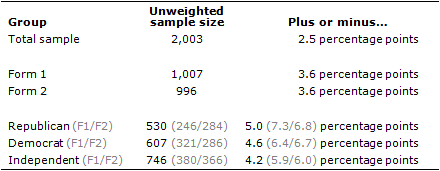General Public Survey
Results for the general public survey are based on telephone interviews conducted October 30-November 6, 2013 among a national sample of 2,003 adults, 18 years of age or older, living in all 50 U.S. states and the District of Columbia (1,001 respondents were interviewed on a landline telephone, and 1,002 were interviewed on a cell phone, including 524 who had no landline telephone). The survey was conducted by interviewers at Princeton Data Source under the direction of Princeton Survey Research Associates International. A combination of landline and cell phone random digit dial samples were used; both samples were provided by Survey Sampling International. Interviews were conducted in English and Spanish. Respondents in the landline sample were selected by randomly asking for the youngest adult male or female who is now at home. Interviews in the cell sample were conducted with the person who answered the phone, if that person was an adult 18 years of age or older. For detailed information about our survey methodology, see http://pewresearch.org/pewresearch-org/politics/methodology/
The combined landline and cell phone sample are weighted using an iterative technique that matches gender, age, education, race, Hispanic origin and nativity and region to parameters from the 2011 Census Bureau’s American Community Survey and population density to parameters from the Decennial Census. The sample also is weighted to match current patterns of telephone status and relative usage of landline and cell phones (for those with both), based on extrapolations from the 2012 National Health Interview Survey. The weighting procedure also accounts for the fact that respondents with both landline and cell phones have a greater probability of being included in the combined sample and adjusts for household size among respondents with a landline phone. Sampling errors and statistical tests of significance take into account the effect of weighting. The following table shows the unweighted sample sizes and the error attributable to sampling that would be expected at the 95% level of confidence for different groups in the survey:

Sample sizes and sampling errors for other subgroups are available upon request. In addition to sampling error, one should bear in mind that question wording and practical difficulties in conducting surveys can introduce error or bias into the findings of opinion polls.
Survey of Council on Foreign Relations Members
Results for the survey of Council on Foreign Relations (CFR) members are based on online interviews conducted October 7-November 11, 2013 with 1,838 CFR members, under the direction of Princeton Survey Research Associates International. All 4,747 members of the Council on Foreign Relations were invited to participate in the survey. The overall response rate for the survey is 39%.
Founded in 1921, the Council on Foreign Relations is an independent, nonpartisan membership organization, think tank and publisher dedicated to helping its members, government officials, journalists and others better understand the world of foreign policy. CFR publishes Foreign Affairs, a journal of international affairs and U.S. foreign policy. Individual membership is limited to U.S. citizens and U.S. residents in the process of becoming citizens. New members must be nominated by a current member. For more information about CFR, see http://www.cfr.org.
Each member was mailed a letter describing the nature and purpose of the survey and encouraging their participation. This letter contained a URL and a password for a secure website where the survey could be completed. CFR members who did not participate in the first week after the mailing were sent follow-up e-mails to encourage them to participate in the survey.
In estimating the overall balance of opinion among Council on Foreign Relations members based on the total sample of 1,838 interviews completed, the margin of error attributable to sampling is plus or minus 2.3 percentage points. The sample characteristics of survey participants closely match the demographic profile of all CFR members in terms of age, gender and type of membership. In addition to sampling error, one should bear in mind that question wording and practical difficulties in conducting surveys can introduce error or bias into the findings of opinion polls.
Additional Data Source
In addition to the main surveys described above, this report is supplemented with public opinion data from an omnibus survey conducted October 31-November 3, 2013 among a national sample of 1,002 adults 18 years of age or older living in the continental United States (501 respondents were interviewed on a landline telephone, and 501 were interviewed on a cell phone, including 228 who had no landline telephone). The survey was conducted by interviewers at MKTG under the direction of Princeton Survey Research Associates International. A combination of landline and cell phone random digit dial samples were used; both samples were provided by Survey Sampling International. Interviews were conducted in English. Sampling errors and statistical tests of significance take into account the effect of weighting. The following table shows the unweighted sample sizes and the error attributable to sampling that would be expected at the 95% level of confidence for different groups in the survey:

Sample sizes and sampling errors for other subgroups are available upon request. In addition to sampling error, one should bear in mind that question wording and practical difficulties in conducting surveys can introduce error or bias into the findings of opinion polls.




